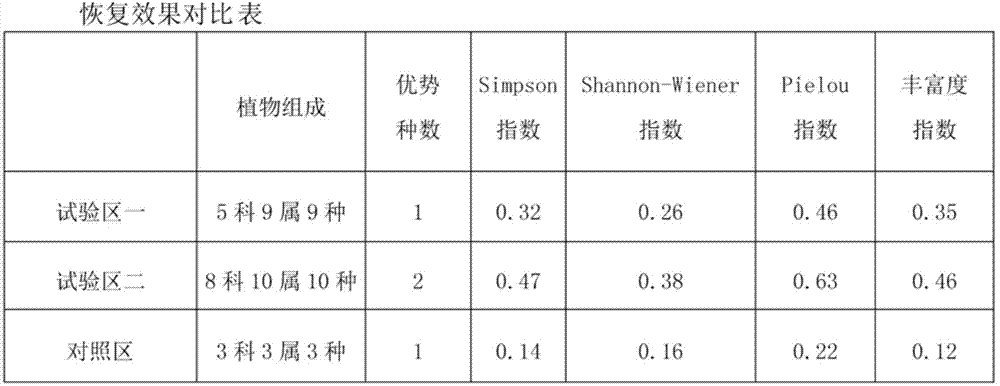Wetland vegetation protection or restoration and reconstruction method
A wetland vegetation and weight technology, applied in the fields of botanical equipment and methods, seed treatment methods, climate change adaptation, etc., can solve the problems of large community dominance, difficult vegetation restoration, and few species, achieving good effects and avoiding The effect of drifting with water or wind
- Summary
- Abstract
- Description
- Claims
- Application Information
AI Technical Summary
Problems solved by technology
Method used
Image
Examples
Embodiment 1
[0033] Example 1 : Collect or prepare wetland vegetation seeds for restoration: collect native species, mainly wetland dominant species seeds in good wetland vegetation areas, collect, process and purify. The main species of river wetlands in arid areas of Xinjiang are Salicornia, Salina, Phragmites, Suaeda salsa, Salicylum, Tamarix, Lycium barbarum, Rush, and Sea Milkweed, etc., which can be used as seeds to restore wetland vegetation.
[0034] Take 10 parts of water by weight, add 3 parts of yellow clay and 0.05 parts of nutrient, the nutrient is formulated into a compound mixture from diammonium phosphate and potassium sulfate at a weight ratio of 1:1, after fully mixing, add Mix 1 part of water-retaining agent evenly to form an adhesive. The water-retaining agent is a water-retaining agent produced by Renqiu Changxing Petrochemical Co., Ltd. The main component is potassium polyacrylate. Add 0.3 parts of the above-mentioned wetland vegetation to 100 parts of adhesive by we...
Embodiment 2
[0036] Example 2 : Take 10 parts of water by weight, add 2 parts of yellow clay, 0.03 parts of nutrient, and 2 parts of water retaining agent, and mix well to form an adhesive. The nutrient is a compound mixture prepared from diammonium phosphate and potassium sulfate at a weight ratio of 1:1.6. The water-retaining agent is a water-retaining agent produced by Guangzhou Yourun Chemical Co., Ltd., and its main component is cross-linked acrylamide / acrylic acid Potassium copolymer. Add 0.5 parts of wetland vegetation seeds to 100 parts of adhesive by weight, mix evenly and apply on the seed paper with a thickness of 1mm, and dry until the two sheets of paper are stacked without sticking. The sub-paper is 40g paper, the size is a rectangle with a side length of 20-30cm, and it is buried according to the best time for the germination of dominant seeds. Choose an area with a relatively flat riverside, a slope of less than 8 degrees, water replenishment conditions or good water con...
Embodiment 3
[0037] Example 3 : Get 10 parts of water by weight, add 5 parts of yellow clay, 0.05 part of nutrient, and 2 parts of water-retaining agent to fully mix and evenly form an adhesive. The nutrient is diammonium phosphate, and the water-retaining agent is polyacrylamide, poly Sodium acrylate copolymer cross-linked product. Add 0.1 part of wetland vegetation seeds to 100 parts of adhesive by weight, mix it evenly, and apply it on 60g of newsprint, with a thickness of 5mm, and let it dry for later use. From the end of February to the beginning of March before spring, choose a river that is relatively flat and has a Areas with good water supplement conditions or good water conditions, poor natural vegetation, and lack of provenance are used as burial areas. The seed paper is arranged in the shape of a character, spread in the burial area at an interval of 40 cm, and covered with 1-2 cm of soil. , and fixed with wood brazing, fixed point 20cm interval.
PUM
 Login to View More
Login to View More Abstract
Description
Claims
Application Information
 Login to View More
Login to View More - R&D
- Intellectual Property
- Life Sciences
- Materials
- Tech Scout
- Unparalleled Data Quality
- Higher Quality Content
- 60% Fewer Hallucinations
Browse by: Latest US Patents, China's latest patents, Technical Efficacy Thesaurus, Application Domain, Technology Topic, Popular Technical Reports.
© 2025 PatSnap. All rights reserved.Legal|Privacy policy|Modern Slavery Act Transparency Statement|Sitemap|About US| Contact US: help@patsnap.com

